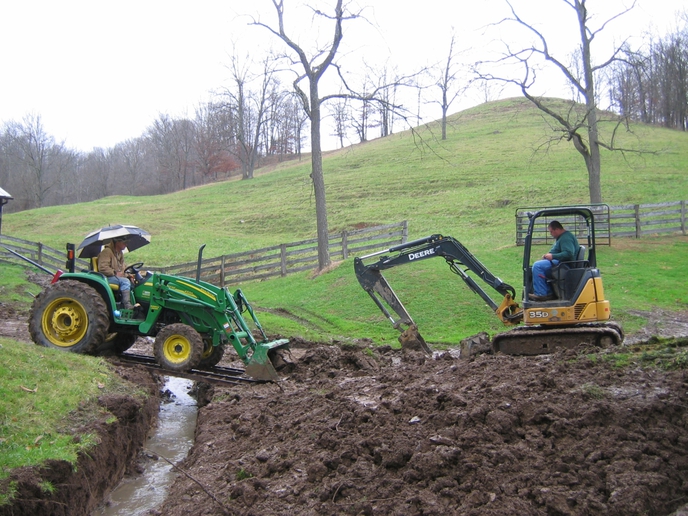Dependable Pad Construction for Your Task Needs
Wiki Article
Culvert Setup Made Easy: Step-by-Step Guide for Success
Installing culverts may appear like an uncomplicated job, but ensuring a successful end result requires cautious preparation and implementation. From choosing the appropriate culvert size to integrating correct drainage steps, each action in the setup process plays an important duty in the functionality and durability of the culvert system. By adhering to a methodical technique and paying interest to crucial details, the installment can continue efficiently, minimizing potential concerns down the line. Stay tuned to reveal the crucial steps and considerations that can make culvert installment a seamless and successful undertaking.Picking the Right Culvert Size
Selecting the proper culvert size is essential for ensuring reliable water flow and structural honesty in culvert setup tasks - Pad Construction. The size of the culvert directly impacts the circulation ability of water through the structure. A culvert that is too tiny can bring about flooding and overflow, while one that is too big may result in reduced water velocity, possibly triggering sediment build-up and obstructionsTo determine the best culvert dimension, elements such as the watershed area, peak circulation prices, and hydraulic effectiveness need to be thoroughly thought about. Computations based upon these specifications assist in selecting a dimension that can properly take care of the expected water volume while reducing the danger of obstructions and architectural failing.
It is crucial to speak with design standards and standards to ensure that the chosen culvert size meets the project needs and neighborhood laws (Pad Construction). By choosing the appropriate culvert dimension, task managers can maximize water circulation, stop prospective concerns, and enhance the total effectiveness and long life of the culvert setup
Preparing the Installation Website
Reliable culvert setup requires thorough preparation of the setup site to make certain ideal structural assistance and functionality. Prior to starting the installation procedure, it is important to clear the site of any kind of debris, plant life, or obstructions that can hamper the culvert's placement.Furthermore, it is essential to take into consideration aspects such as soil structure, groundwater degrees, and environmental effects when preparing the setup site. Performing a complete site analysis can aid recognize any type of potential obstacles or risks that might impact the culvert's performance. By making the effort to prepare the installation website appropriately, you can assist guarantee an effective culvert installment that fulfills architectural needs and makes sure long-term functionality.
Putting the Culvert Correctly

The grade at which the culvert is positioned is vital for maintaining a correct incline for water flow. A progressive incline helps stop pooling and advertises effective water drainage. Additionally, the culvert must be oriented appropriately to make sure that the inlet and outlet are in the proper locations. This positioning is crucial for the culvert to function efficiently in site here managing water circulation.
Backfilling and Compacting the Dirt
Appropriate backfilling and compaction of the soil around the culvert is important to guarantee stability and protect against prospective issues in the future. Once the culvert is correctly positioned, the following vital action is to backfill the location around it with ideal product.Compaction assists in minimizing the possibilities of settlement and ensures consistent support around the culvert. It is important to compact the soil evenly on all sides of the culvert to preserve its architectural integrity.
Correct backfilling and compaction not only provide security to the culvert but also help in avoiding dirt erosion and maintaining the durability of the culvert system.
Ensuring Appropriate Water Drainage Assimilation
Integrating reliable drain remedies plays a critical role in the general performance and durability of culvert installments. Appropriate water drainage integration is essential for taking care of water circulation, protecting against erosion, and making sure the architectural integrity of the culvert system. To attain this, it is vital to design a comprehensive drainage plan that thinks about factors such as the volume of a fantastic read water anticipated, the topography of the area, and the kind of soil present.
Additionally, incorporating attributes like disintegration control procedures, such as riprap or plants, can additionally improve the effectiveness of the drainage system. By meticulously intending and applying these water drainage remedies, culvert installations can operate effectively and stand up to the test of time.
Verdict
In verdict, appropriate culvert installation is important for maintaining reliable drain systems. By selecting the appropriate culvert size, preparing the installment site, positioning the culvert appropriately, backfilling and compacting the dirt, and making sure proper water drainage combination, success can be attained. Adhering to these actions will help make sure the longevity and performance of the culvert, ultimately adding to the overall success of the drain system.Report this wiki page